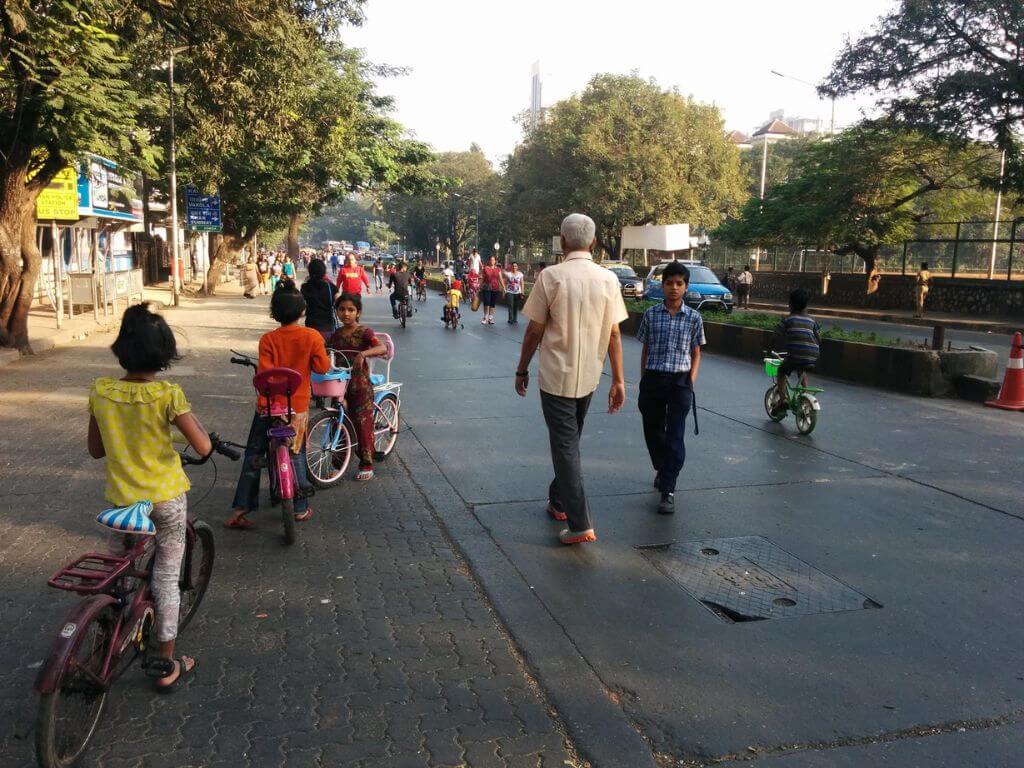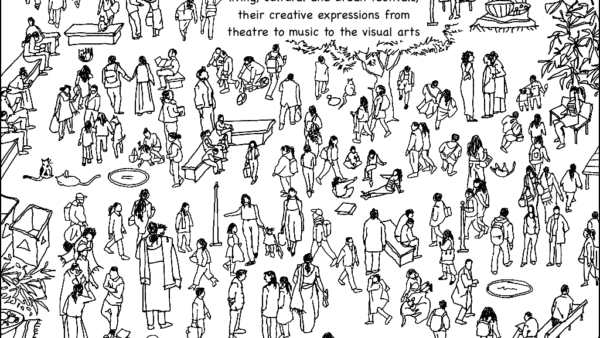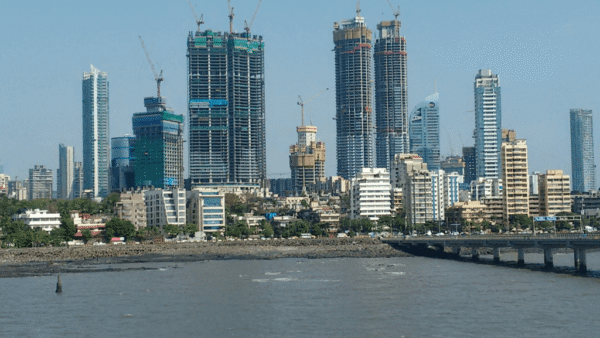Construction of roads and flyovers is increasingly becoming the symbol of ‘development’ in our cities. Mumbai’s Coastal Road is hailed as a significant addition to the city’s road network. Vehicle congestion on roads, lack of pavements in many areas or inaccessible pavements in others, people forced to dodge vehicles to negotiate their way everyday, flyovers which are only carriageways for automobiles have seeped the idea in people that roads are – and should be built – for vehicles.
To dispel this widely-held notion and persuade the system to turn roads into streets, the Equal Streets movement was started. Inspired by Ciclovía, streets in the Colombian capital of Bogota which are closed to all traffic to become bicycle paths,[1] the movement in Mumbai stretched from November 2014 to May 2015 every Sunday. Its purpose was to keep out all vehicles from certain roads and open them for cyclists, walkers, joggers and people who wanted to claim the space in happy ways. While the movement did not continue, it inspired similar action in other areas of Mumbai.
Dhawal Ashar, program head (transport) at the World Resources Institute, was a founder member and trustee of Equal Streets. “People came together to invent games that I had never seen before. Kids used to sit on the road to make paintings with chalk. It was a festival every Sunday…Streets for people is not a space problem; it’s a management and design problem,” Ashar said in this interview to Question of Cities.
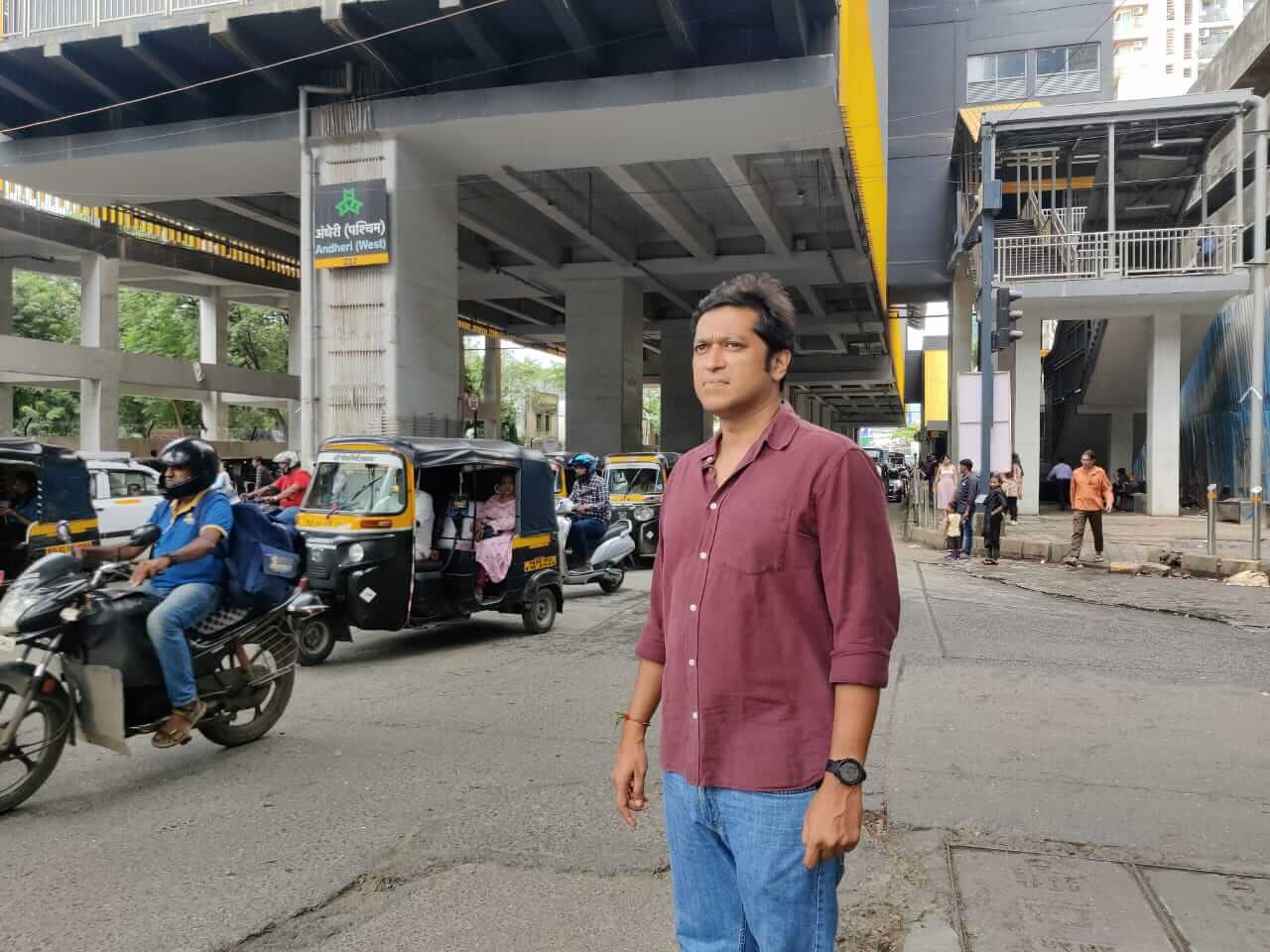
Photo: Jashvitha Dhagey
Would you start by talking about how the plan for Equal Streets came about and its importance to Mumbai?
This idea has been around in the world for a while, drawn from what’s called Ciclovía (cycleway in Spanish), in Bogota, Colombia, in which major roads were shut for cars on Sundays and public holidays and opened for cyclists, pedestrians and skaters. It started back in 1974 when cities were experiencing very high automobile volumes resulting in traffic crawl and congestion.
At WRI, we had colleagues from Bogota often speak about this; some colleagues from India visited too. In 2014, the WRI’s Delhi office first executed this with The Times of India and local partners. It was launched as ‘Raahgiri Day’ in Gurugram in May 2014. In Mumbai, with groups of citizens and cyclists, we formed a trust of 14 people including Binoy Mascarenhas, Renuka Tahiliani, Rishu Shah, Ashoke Pandit, Priyanka Vasudevan, Nazneen Hussain, Samarth Das and PK Das. A big champion was the then Police Commissioner Rakesh Maria who implemented the plan. Several conversations and meetings and a lot of meticulous planning led to the launch of Equal Streets Day on November 9, 2014. We had permission to conduct it every Sunday till the end of May 2015. It was to stop with the monsoon and we were to review it.
Which areas of Mumbai did it cover? How were these chosen?
We started this with high ambition, we wanted to do this on roads with high traffic volumes. The reason to take up a major road was two fold; first, main roads are mostly easily accessible by rail and buses, allowing more people to come. Second, and most importantly, to demonstrate that a few streets closing down on a Sunday morning will not bring the world down. The Equal Streets movement chose a 6.5 kilometres Linking Road to SV Road loop, an arterial road, to show that this road with heavy traffic can be shut for a while.
From here, it went to localities like Powai and Juhu. We hoped to stretch it for 20 kilometres north of Bandra, into the suburbs, but it was difficult with the metro construction and high air pollution. We made efforts to scale this across Mumbai; there were many requests too which we couldn’t fulfil but we were glad to see that people did their versions. One of those was Malad Masti near Mindspace where it still happens once a year.
Over time, this model has had to move to spaces with lesser traffic, which is understandable. Sunday Streets happened earlier this year at Marine Drive, Bandra, Goregaon, DN Nagar, Mulund and Vikhroli. The traffic in Mumbai in 2023 is a lot more than in 2014 but Sunday Streets demonstrated that car-free streets are possible.
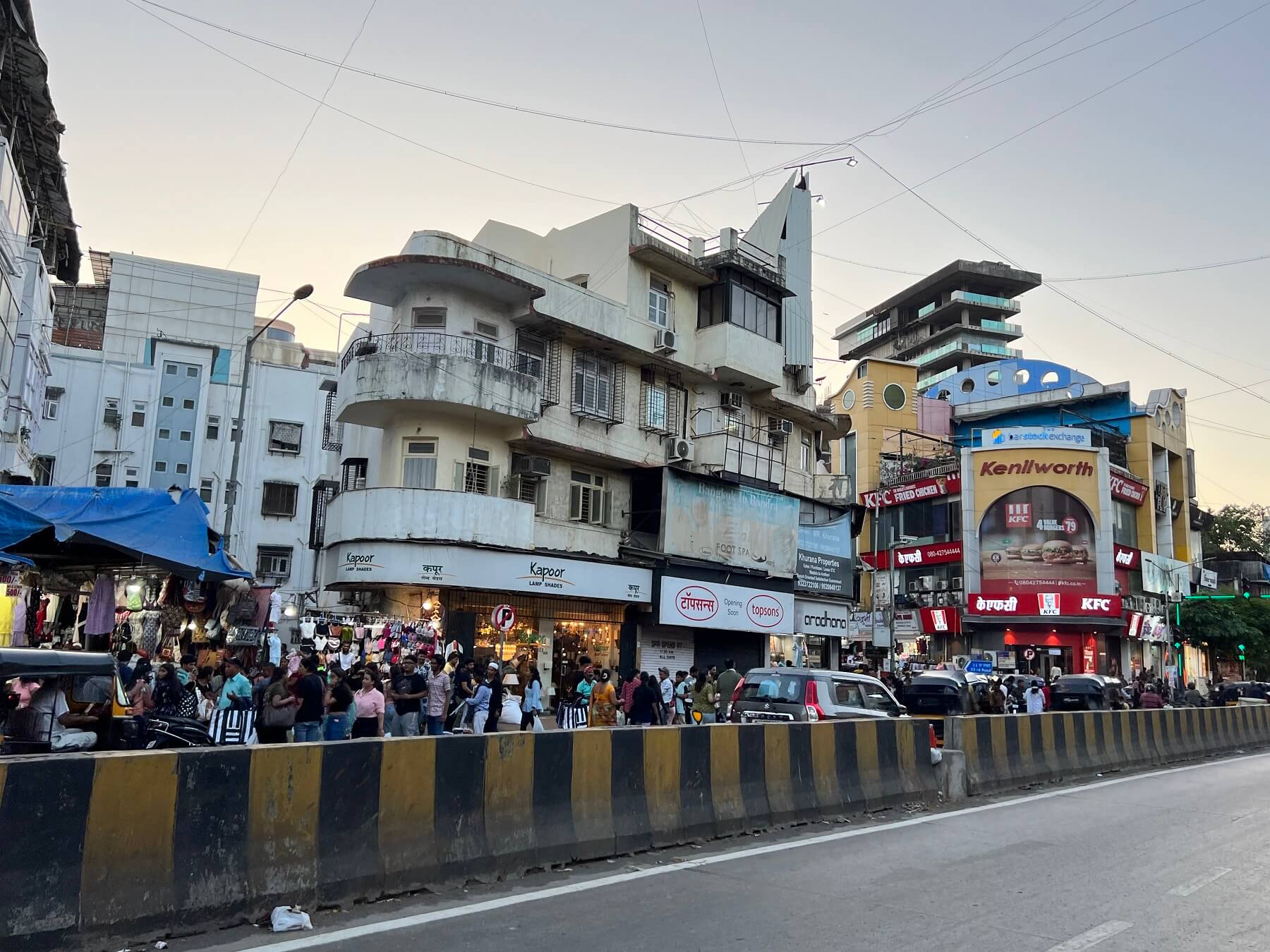
Photo: Maitreyee Rele
What would you say is the impact of Equal Streets?
Our surveys revealed that most people were coming from a two-kilometre radius and the community was excited. Interestingly, at the time, bicycle sales in that area actually shot up 33 percent. Equal Streets was an entirely non-commercial, non-political initiative. We were initially worried about what people would do on an empty street, so we reached out to several organisations to set up activities along the route. We did not allow any banners or posters, nor any commercial transactions. And it did trigger a lot of interaction; later, we were flooded with requests but the most pleasant surprise was people coming together to create their own activities. Kids would paint the road with chalk, and the moment traffic started, this would be wiped out, so it wasn’t a worry. Every Sunday was a festival well documented by The Times of India and also by Youtubers which inspired more people to come.
There was some opposition too. A few local residents claimed that their access roads were blocked and asked about the passage of emergency vehicles. We had planned this meticulously, I knew every road in the area like the back of my hand. For the building lined along the route, there was no restriction. A volunteer was posted to ensure safe access in and out of the building. Emergency vehicles were always allowed. In one instance, people participating in Equal Streets did make way for an ambulance.
The core idea of the Equal Streets movement is to demonstrate that streets are not just conduits for traffic, that we need to build not just as roads for cars but streets for people. The Trust was clear that this cannot just be a demonstration; it had to be more. We were hoping to actively scale up Equal Streets day to more venues and prepare designs for better and more accessible streets. WRI worked with PKDA (PK Das & Associates) to create a plan for Linking Road and SV Road in Bandra, Khar and Santacruz with more space for pedestrians, increased pedestrian and non-motorised infrastructure, while ensuring there would be no traffic concerns. But it couldn’t be put in place because a metro line was coming up on these roads.
That was also a time when a spate of construction, including the metro along S.V. Road, had begun in Mumbai. So, the alternative plan couldn’t go further. I still believe that Equal Streets Day succeeded in sensitising people, all stakeholders, of the possibility of a people-friendly street in Mumbai. In the years following that, WRI India managed to work with the BMC to improve safety and accessibility on several streets and intersections in Mumbai. It’s hard to measure this but I can tell that Equal Streets Day did play a role in accelerating this change.
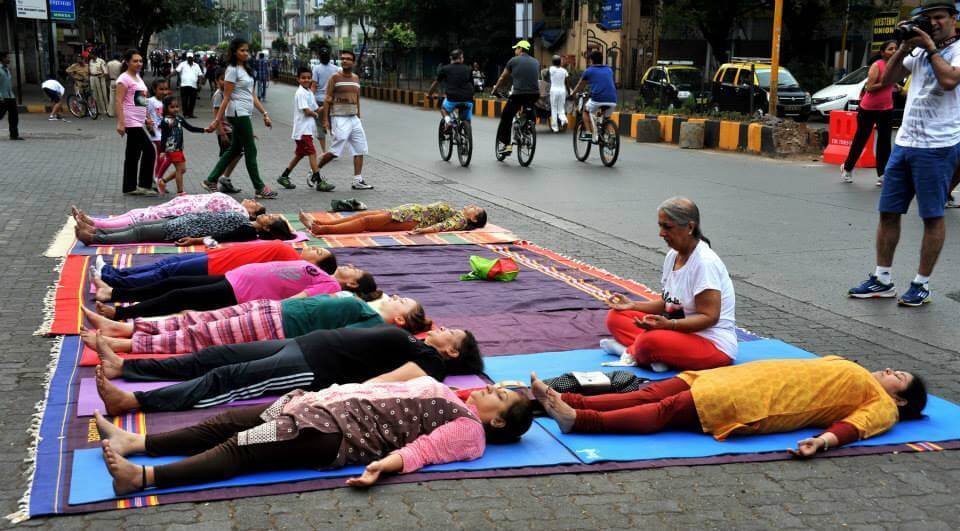
Photo: Equal Streets/ Facebook
Why do you think the idea was not embraced by the authorities as you all wanted? Who are the stakeholders now and how can this move ahead?
It was working well and scaling up too. But, initially, maybe, sustaining an event such as this one every Sunday can be strenuous, especially on our Traffic Police. The other thing is that, from 2016 or so, the construction of many metro lines started at once which meant parts of many of our key arterials were blocked at the same time. Then, there is routine road maintenance work from October till May, which are also the months when open streets can happen. It can become overbearing to do or sustain such programmes on roads with high traffic. But, it did come back, albeit briefly, as Sunday Streets and worked beautifully on Marine Drive, Carter road and many other places. The movement is on, not as strongly as one would have thought but people pick this up, it can quickly become a citizens’ movement. When you open a street up to people, they create magic.
Equal Streets day was truly equal and universally accessible. The universal accessibility was because people got to tread freely on the carriageway. Our footpaths however are far from being universally accessible. A few weeks ago, in a capacity-building exercise with the BMC, we put the engineers on wheelchairs to experience first hand how disabled people negotiate the streets. It was such a revelation. Even on stretches of footpaths that appear smooth, wheelchairs would be stuck because of really tiny bumps, maybe not more than a few centimetres. These little things make all the difference. In my son’s school, a family has not opted for the school bus simply because the bus drop is at an intersection and the child will have to cross it to reach home – a risk that parents don’t want to take.
Do you think Mumbai can still turn its roads into streets?
I strongly believe that we are at a very critical crossroad in Mumbai. In the next three years, we are going to see an addition of public transport capacity through metros and buses that we haven’t seen in many decades, about 300 kilometres of metros and 10,000 buses. The city’s focus should now be on building wider and more accessible footpaths, safer intersections and more accessible station areas. That will be a game changer. This is also the time to start planning on demand side measures, the best of which is parking. If you can’t park, you’re likely to not take your personal automobile. Until now, many people would complain about the lack of alternatives, but, with the addition of so much public transport capacity, there should not be any room for that. But the key to enable higher public transport access is to build better ‘streets for people and not just roads for cars’, build streets that promote walkability.

Photo: Equal Streets/ Facebook
What do you think cities need for streets to become more equitable and also greener?
The best way to achieve this is to build cities that focus on moving people. A people-friendly city will be safe, accessible and resilient. And the numbers clearly support that. In Mumbai, mere 7 percent trips are made by cars whereas over 50 percent of all trips are by foot. Yet, walk any street and see the space distribution; it is the exact opposite. The automobile surge is not limited to Mumbai. Every city in some way or the other is going through this. The recent traffic jam on Outer Ring Road in Bengaluru became national news. Now, with rising climate threats, it is more important than ever to reimagine our cities’ mobility.
Our streets support a lot of livelihoods. A very sanitised imagination, therefore, isn’t inclusive. We need a lot more engagement and dialogue among all stakeholders to ensure that our streets work for all and leave no one behind. With diverse stakeholders, dialogue plays an important role.
What is essential when designing pedestrian-only space?
In the case of Mumbai, if you observe anywhere on the street, you will see a lot of unused space or space that could easily be transformed to enable better access. There is a lot of beautification going on lately. For better and more efficient use of space, we need it to be functionally beautiful. At our workshop, we asked the participants to write down what appeared as a problem on sticky notes and we saw that about 75 percent of them were actually design problems which were simple enough to be fixed overnight. In Mumbai we don’t even have to make a place, we just have to make places accessible.
What would it take to revive Equal Streets in Mumbai or to start it in other cities?
The formula is the same, just that, maybe a champion has to take the baton and run for it to become active again. I am quite hopeful about its revival.
Do you think India’s cities can take inspiration from somewhere to become pedestrian-friendly or people-friendly?
There are several cities across the globe that we can draw inspiration from. But, come 2023, our best guide should be our own experience from the last two decades. However, I like how New York has transformed its streets over the years. Melbourne is another great example of a city that transformed itself from not having enough pedestrians to becoming one of the most pedestrian friendly cities.
I also think it’s time that Indian cities, especially the big ones, start actively working on the demand side too. As I said, parking is the best form of demand management. Several European cities transformed their streetscape using parking as a tool to manage demand.
Mumbai has a glorious opportunity to completely transform that way it moves now more than ever before. And it’s not like designing for pedestrians will increase congestion. If anything it will improve traffic efficiency too.
Cover photo: Equal Streets/ Facebook

